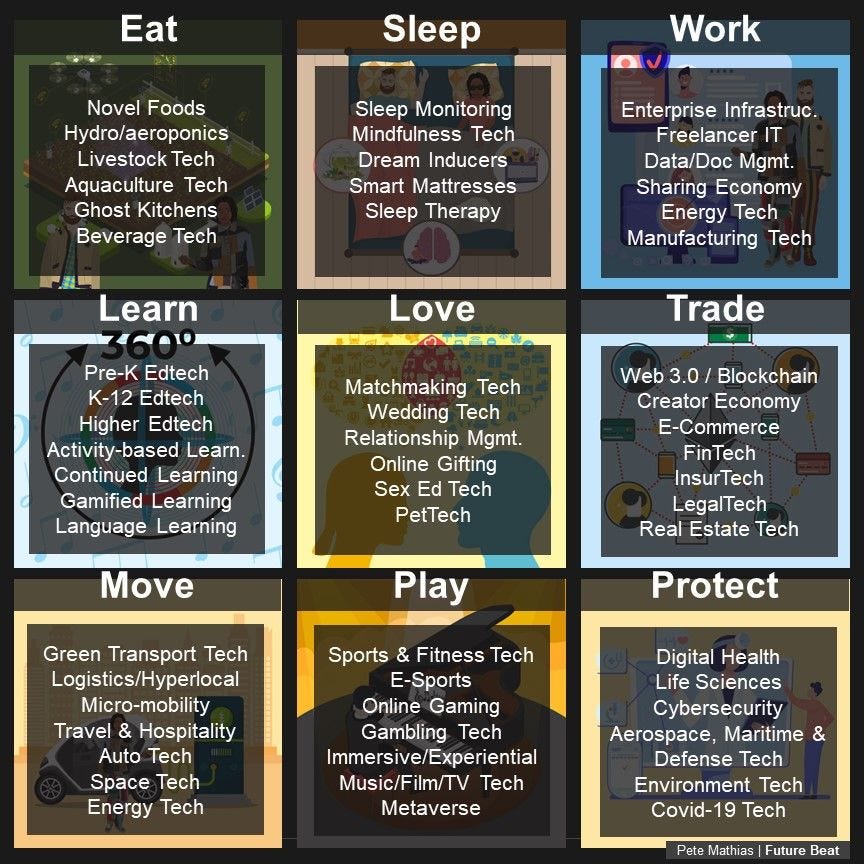Want the pulse on posterity? You’ve found your groove: Welcome to Future Beat.
Hi everyone!
There is no word, no category for this beat. It is an “out there,” emerging space. The early adopters are rule-breakers (which is the first sign of a breakthrough).
I’ll call it “Mrs. Doubtfire Tech,” after the eponymous movie character who sneakily did two jobs at once. “Double Dipping Tech” also works. Whatever you call it, it’s a trend shaping (dictating?) the Future of Work— so pay attention.
Drum roll please 🥁🎶
Pete
What is the historical setting?
The Industrial Revolution was a hardware revolution— with one exception. There was a piece of software that changed the world.
Steam engines, railroads, telegraphs— for all its hardware output, the industrial revolution produced one software innovation still used today: the “organization chart.”
Org charts are protocols for how companies operate (rules like “Person X reports to Y” or “Function X has Decision Rights Over Y”). This software hasn’t changed much in 200+ years— Facebook operates pretty much the same way the Erie Railroad Company did (people w/ bosses w/ bosses).
The org chart is legacy software— untouched by innovation— until now.
What trends challenge the org chart?
At least three forces are dismantling the org chart:
Talent: Remote work busts hierarchies. Zoom, Slack etc. have a “flattening effect” (C-Suites avail w/ click of a button!). Employee monitoring is harder— bosses can’t be so bossy. Then, there’s a mindset shift “Quiet Quitting,” a fade-to-black for the hustle mentality (or as NPR puts it “Acting your Wage”). Gloat’s VP of Global Marketing Ruslan Tovbulatov nails the trend: “You are not your job.”
Economy: The Cost of Living is soaring— breaking outside the “9 to 5 box” with two+ jobs is a survival strategy too. The latest 12-month percentage change in Consumer Price Index (CPI) tells it all:
Tech: Horizontal tech is weakening the org chart’s grip over organizations. For example:
Robotic Processing Automation (RPA) or automating repetitive tasks done on a computer. Employers were doing it to eliminate/reduce back office jobs. Now, at home workers are using it to automate their own jobs at home (a friend who is a Data Scientist for example now goes on long runs while the code he wrote does his job for him).
AI/ML: For example, Generative AI (code capable of writing poems, blogs, artwork etc) helps people in creative fields do jobs faster (opening up opportunities to take on new jobs at the same time). See this recent article in HBS Review. Or also just see the images I made above via DALLE 2.
Marketplace tech: Pete Flint at NFX nails this trend in May 2020. “Marketplaces are moving to onboard standardized and attributed human capital with a greater complexity of service.” We are starting to see places to hire technical roles (i.e. a scientist) for part-time work, not just a handyman. This could shatter org charts if companies begin fractionalizing their back offices— and sharing FTEs with each other.
So, what is “Mrs. Doubtfire Tech”
“Mrs. Doubtfire Tech” describes jobs with these traits:
Simultaneous: people doing 2+ at the exact same time (like Mrs. Doubtfire in the famous movie)
Scalable: virtual in nature, conducive to “working from home”
Surreptitious: there is a sneaky disposition, since the employers often do not know the employee is double-timing. In other words, this:
Why is Mrs. Doubtfire Tech a big deal?
I always look out for “Asset multipliers” — tech helping us making more money with what we have (i.e. our “asset base.”) AirBnb helped you make more money with your home, Uber with your car, Upwork with your skills, etc.
The next wave— happening now— is tech that helps you make more money with your career. This increases your earning even if your capacity (i.e. your avail hours in the day) stay constant, or mostly unchanged.
Here’s my visual of this:
The asset multiplier that will help remote workers— many who do complex jobs that often aren’t hired often — will be big.
What are the key numbers driving adoption?
Here are some big relevant numbers driving adoption of Mrs. Doubtfire Tech:
44% of Americans currently work 2+ jobs to make ends meet
12+ jobs in lifetime for avg. person
269 occupations in 1950 census versus 569 occupations in 2018 census
29% of workers cite inflation as a reason for starting side hustles
$455B is the 2023 Project Gross Volume of the Gig Economy
The story these tell together: people are already doing many jobs in a lifetime— they will soon start to do many jobs in a day.
Looking forward: the trends to monitor
As we look ahead, if Mrs. Doubtfire Tech is successful, we will see the following:
Behavior shift from “hiding” to “promoting” Mrs. Doubtfiring (2+ jobs)
Employers may start to share “Full Time” employees with each other — resulting in some “win win” economics for the employer and employee
Great Power Competition — especially with China— forcing the U.S. to rethink how it can fortify its own economic engine with labor-focused tech (in other words, do more with less)
We will start to see talent and employers embrace the fractionalization of the workplace— rejecting the idea what there is 1 boss of each 1 person.
Companies— and talent— will also need to adjust. As observed by the CEO and co-founder of AdeptID Fernando Rodriguez-Villa:
“Talent needs to navigate an increasingly diverse set of employment options and employers need to discover talent that has increasingly "unconventional" backgrounds. This is where robust AI matching can unlock a ton of mobility.”
What are some illustrative companies?
We are early days in Mrs. Doubtfire tech. No company is playing directly in this sandbox (to my knowledge), but some are close. These include companies that are helping companies find talent within and beyond their current payroll:
Upwork (and other companies like Fiverr, Toptal, etc) helped usher the “Gig Economy” by giving freelancers multiple jobs to take on. Upwork now has 12M+ freelancers on platform in 180 countries and is publicly traded ($1.6B market cap).
Gloat is a fascinating, category-creating, visionary company that is building an AI/ML-powered marketplace to support cross-functional placement. There are 1.1M+ users on platform in 120 countries according to the company, and they have now raised $192M from top-flight investors.
AdeptID: a Talent Matching startup uses AI/ML to identify talent on the basis of skills and potential (focused on under-recognized parts of the workforce). A B-Corp, AdeptID's models help any Future-of-Work application connect talent and opportunity.
And there are so many more— so let me know what you’re seeing!
Where can you go to learn more?
Video: Navigating the Future of Work w/ Jeff Schwartz (VP at Gloat)
Podcast: Leading the Future of Work
Book: Work Won’t Love You Back
TikTok: search “Two Jobs at the Same Time”
Summary
First-movers taking on two jobs at once are creating an entirely new category of organizational design— one that outright rejects the org chart inherited by industrialization. Call it what you want— Mrs. Doubtfire Tech or not— but it’s a new wave innovation for Future of Work.
Future Beat
Future Beat gives periodic insights on “common words” (which are big markets) and how tech drives change in how we do these words. This piece focused on “Work.”
Jobs! (sorted by “Word”)
Want to build the future or have a friend who does? I carefully curate incredible openings at incredible startups… scroll to bottom!
Health. Oula (maternity care) has 1 opening
Build. Oliver Space (room builder) has 20 openings
Wear. Archive Resale (peer-to-peer resale) has 11 openings
Work. Gloat (future of work) has 129 openings
Work. One Schema (automation) has 3 openings
Don’t miss a beat—subscribe.










